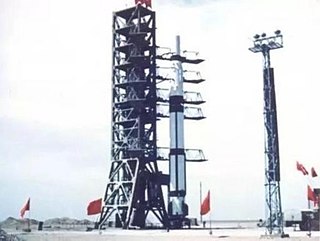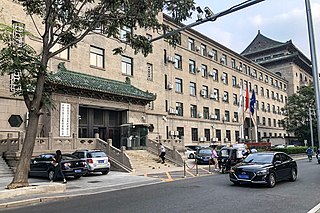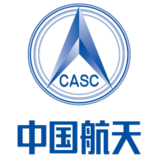
The space program of the People's Republic of China is about the activities in outer space conducted and directed by the People's Republic of China. The roots of the Chinese space program trace back to the 1950s, when, with the help of the newly allied Soviet Union, China began development of its first ballistic missile and rocket programs in response to the perceived American threats. Driven by the successes of Soviet Sputnik 1 and American Explorer 1 satellite launches in 1957 and 1958 respectively, China would launch its first satellite, Dong Fang Hong 1 in April 1970 aboard a Long March 1 rocket, making it the fifth nation to place a satellite in orbit.

The China National Space Administration (CNSA) is a government agency of the People's Republic of China headquartered in Haidian, Beijing, responsible for civil space administration and international space cooperation. These responsibilities include organizing or leading foreign exchanges and cooperation in the aerospace field. The CNSA is an administrative agency under the Ministry of Industry and Information Technology.

China North Industries Group Corporation Limited, doing business internationally as Norinco Group, and known within China as China Ordnance Industries Group Corporation Limited, is a Chinese state-owned defense corporation that manufactures commercial and military products. Norinco Group is one of the world's largest defense contractors.
The MAZ-543/MAZ-7310 "Uragan" is a Soviet/Belarusian 8×8 artillery truck designed and developed by MAZ, in what is now Belarus.
The China Academy of Space Technology (CAST) is a Chinese space agency and subordinate of China Aerospace Science and Technology Corporation (CASC). The agency was founded on 20 February 1968, and is the main spacecraft development and production facility in China. On 24 April 1970, CAST successfully launched China's first artificial satellite Dong Fang Hong I.

The WS2400 is a 8x8 special heavy-duty truck developed and built by Wanshan Special Vehicle and used by the People's Liberation Army of the People's Republic of China as a transporter erector launcher (TEL) platform and is a reverse engineered version of the MAZ-543 missile Transporter erector launcher.
Sun Jiadong is a Chinese aerospace engineer who is an expert in carrier rocket and satellite technology. He has long served as a leader of Chinese satellite projects, and is currently the chief designer for the Chinese Lunar Exploration Program. Sun is a member of the Chinese Academy of Sciences and of the International Academy of Astronautics. Jiadong is also known as the " Father of Chinese Satellites".
Sino Satellite Communications Co., Ltd. known also as SinoSat is a Chinese company.
Wanshan Special Vehicle, officially Hubei Sanjiang Space Wanshan Special Vehicle Co., Ltd (Ch:湖北三江航天万山特种车辆有限公司), is a truck and bus manufacturer in China. Its WS-series military trucks are used by the People’s Liberation Army; it is a major manufacturer of transporter erector launchers (TEL).

Ma Xingrui is a Chinese politician and aerospace engineer who is the Communist Party secretary of Xinjiang. Prior to that, he had served as the Vice Minister of Industry and Information Technology, Head of the Political and Legal Affairs Commission of Guangdong, Communist Party Secretary of Shenzhen, Deputy Party Secretary of Guangdong, and Governor of Guangdong. Ma is a member of the Politburo of the Chinese Communist Party.

China Energine International (Holdings) Limited, or China Energine, is a Hong Kong-based and Cayman Islands-incorporated holding company. The controlling shareholder was Chinese state-owned mega-conglomerate China Aerospace Science and Technology Corporation (CASC). The company was formerly known as CASIL Telecommunications Holdings Limited; CASIL was an acronym of China Aerospace International Holdings Limited, a listed subsidiary of CASC.
China Satellite Communications Co., Ltd. known as China Satcom is a Chinese aerospace company that provides services via satellites. The company was a subsidiary of China Aerospace Science and Technology Corporation (CASC).

The Ministry of Astronautics Industry of the People's Republic of China was a ministry of the government of the People's Republic of China which is responsible for the management of research, design and production of rockets, missiles and spacecraft. The ministry was headquartered in Beijing. It existed from 1988 to 1993.
Tiantong is China's first mobile communications satellite system. The first satellite Tiantong-1-01 was launched on August 6, 2016 (UTC+8).
The Academy of Aerospace Solid Propulsion Technology or AASPT, also known as "The Fourth Academy", is a conglomerate of Chinese state-owned enterprises that develops rocket engines that use solid fuel. The group, which employs around 10,000 people, includes some ten entities located in the Shaanxi and Hubei regions, and is headquartered in Xi'an. AASPT is a subsidiary of the China Aerospace Science and Technology Corporation (CASC).
China Academy of Aerospace Aerodynamics or CAAA is a research and manufacturing organization for rockets, missiles and unmanned aerial vehicles (UAVs). Headquartered in Beijing, China, it is a subsidiary of China Aerospace Science and Technology Corporation (CASC).
Liu Shiquan is a Chinese missile technology expert and business executive who served as Chairman of the China North Industries Group Corporation Limited from 2022 to 2024. Previously he served as general manager of China Aerospace Science and Industry Corporation.
Zhang Zhongyang is a Chinese executive and politician, currently serving as general manager of the China Aerospace Science and Technology Corporation.
Lei Fanpei is a Chinese executive and politician who served as chairman of the board of China Shipbuilding Group from 2018 to 2022. Previously he served as chairman of the board of China Aerospace Science and Technology Corporation.
MinoSpace is a major Chinese satellite technology research, development, and manufacturing firm based in the country's capital, Beijing.








